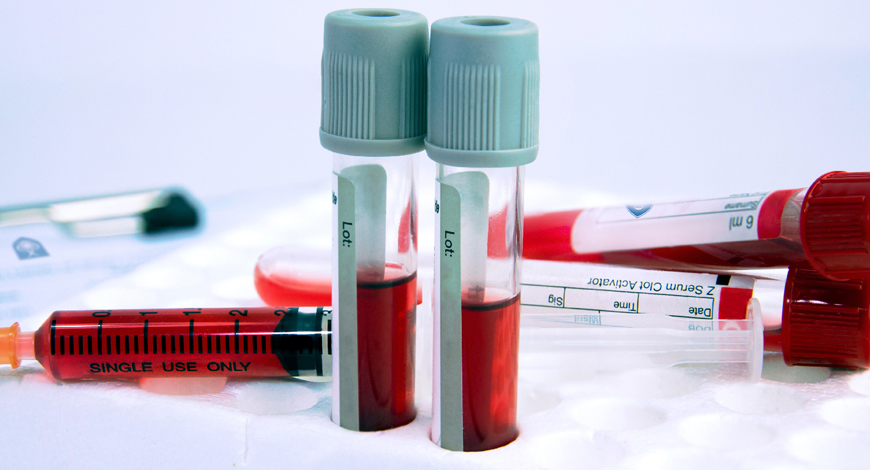Hematology Instruments and Reagents
Proliferation of decentralized healthcare systems to support market expansion

POC testing has become crucial for patient-centric healthcare due to the rapid diagnosis results required for accurate and quicker treatment decisions. A shift from centralized POC testing to decentralized testing for chronic and infectious disease has resulted in convenient access for patients to these diagnostics.
Rapid point-of-care (POC) diagnostics are now more important than ever because of the growing demand for prompt results and improvements in healthcare services. POC has been crucial in controlling the transmission of disease during the recent Covid-19 pandemic epidemic. In order to fit in mobile laboratories, pop-up treatment centers, field hospitals, isolated wards inside hospitals, or distant regions, applicable diagnostics should be easily deployable, simple to use, portable, and accurate, and they should be manageable by staff with little training. Complete blood count (CBC), however, has only lately become accessible at the POC in a user-friendly system.
In-vitro diagnostics (IVD) companies are working to improve specificity and sensitivity of devices so that testing can be done on smaller specimen samples. There is a lot of interest in reducing sample size – using capillary blood samples to do testing. At the same time, technology is getting smaller, cheaper, and more sophisticated. Lab-on-a-chip (LOC) devices, which require just a few drops of blood, already are in use and potentially could be more widely deployed, especially in areas with limited healthcare resources. In addition, diagnostics companies increasingly are combining different technologies into single platforms, so users can perform multiple tests on one sample.
POC testing is becoming more common, popular, and acceptable due to increasing need for more timely results, i.e., better turnaround time (TAT), improvement in healthcare services, and mitigating delays in treatment and reducing overcrowding in areas, such as the emergency department. Advances in technology play a major role in meeting these needs. Complex tests that were performed only in clinical laboratories a decade ago are now becoming available at the POC.
An unmet area of need is the complete blood count (CBC) with a 5-part white blood cell (WBC) differential (diff), which is the most frequently ordered blood test in clinical pathology. Although the CBC is a standard of care for use in diagnosis, monitoring, and guiding treatment of a diverse variety of disorders, the test has been essentially confined to laboratory settings.
The global POC hematology diagnostics market share is expected to reach an estimated value of USD 1.46 billion by 2026 at an accelerating CAGR of 9.06 percent. POC testing has become crucial for patient-centric healthcare due to the rapid diagnosis results required for accurate and quicker treatment decisions. A shift from centralized POC testing to decentralized testing for chronic and infectious disease has resulted in convenient access for patients to these diagnostics.
The increase in the demand for fast turnover testing has allowed many players to develop infectious disease tests for decentralized locations. Thus, the increasing demand for fast and effective diagnostics, which can be performed at home or at the physician’s office for patient ease, has been boosting the demand for decentralized healthcare settings.
The adoption of rapid diagnostic testing is slated to increase in decentralized settings as it enables easy accessibility of medical devices and eliminates the need for transportation. These trends will positively influence the global market growth.
Automation of hematology diagnostics process has led to reduced turnaround time, thereby accelerating the overall treatment regimen. Furthermore, automation has also led to reduced administrative errors and overall costs of diagnostic tests. Thus, it is expected to boost growth of the hematology testing market in the forthcoming years.
There has been a positive impact on the market growth during and post Covid-19 era. The increasing prevalence of blood disorders and infectious diseases is notably driving the POC hematology diagnostics market growth, although factors, such as the high cost of hematology diagnostic products, may impede the market growth.
One of the key factors driving growth in the POC hematology diagnostics market is the increasing prevalence of blood disorders and infectious diseases. With the increase in the prevalence of infectious diseases, such as malaria and blood disorders like sickle cell anemia, thalassemia, and polycythemia, the demand for POC hematology diagnostics is increasing. Rare diseases like thalassemia can be a threat to a person. It is an inherited disorder that is passed down from parents to children through genes. Anemia, another hematology condition, which occurs due to iron deficiency, is often a health concern in women and children. For infectious diseases, such as dengue and malaria, there is a need for constant blood check-ups to monitor the WBC count and total cell counts. With the increasing number of conditions mentioned above, the adoption of POC hematology diagnostics is increasing.
The increase in online marketing is a POC hematology diagnostics market trend that is expected to have a positive impact in the coming years. Online marketing platforms like Clinical Laboratory Improvement Amendment (CLIA) waived, and eBay is widely adopted by the companies to offer a wide range of products to the end-users. Online marketing, as a business strategy, helps mid-sized and small-scale companies to minimize their operational cost by reducing the cost of setting up the sales office, recruitment of direct and indirect sales force, and distribution channel. Companies are focusing on online sales owing to the growing demand for POC hematology diagnostics.
Moreover, purchasing through online platforms offers customers numerous benefits, such as convenience, ease of making payments, discounts, and an efficient comparison between various product offerings. Thus, the growing popularity of online sales channels for hematology diagnostics is boosting the market growth.
Technological advancements are creating ample opportunities for hemostasis diagnostic product manufacturers. Technology is evolving rapidly. In recent years, blood coagulation monitoring has become crucial to diagnosing the causes of hemorrhages, developing anticoagulant drugs, assessing bleeding risk in extensive surgery procedures and dialysis, and investigating the efficacy of hemostatic therapies.
Upcoming trends in hematology
 Thomas John
Thomas John
Managing Director,
Agappe
Hematology instrument and reagent market is one of the fastest-growing segment in the Indian IVD, with a 10-percent share in value. Though hematology segment suffered difficulties throughout the Covid-19 period, a sizable increase is projected in hematology as well as the resumption of elective procedures in future.
Automation replaced manual workload to counter reduced laboratory throughput, accuracy, and cell-counting speed with time. Hematology analyzers have decreased in size with revolutionary advances in computing, electronics and manufacturing, fluidics, and mechanics.
In the upcoming years, the hematology analyzer market in India is anticipated to expand at a CAGR of over 14 percent. This expansion is being fueled by an increase in cases of blood disorders, automated alternatives for blood testing, accessibility, and raised patient awareness following the epidemic. The choice of providers and brands is based on accuracy, repeatability, trouble-free service, and price.
Modern hematology devices cleverly blend impedance technology with original algorithms. Although machines are small, throughput is higher. Modern machines have laser-cut ruby aperture for accurate and precise counting of cellular particles. The new system offers 20 parameters, three histograms, and 60 tests every hour, all of which may be shown on a single screen. PTFE syringes, with a special fluidic system, are used for stable and accurate operations.
Through routine CBC with differential, labs can now access more cellular information thanks to technological advancements in hematology analyzers. The accurate morphological view of various cell characteristics is made possible by cutting-edge flow cytometry analysis, genomics testing, sophisticated image processing, microfluidics, use of multiple scatters, high-speed signal acquisition mechanisms, high-resolution cameras, artificial intelligence, and machine learning techniques.
Optics, electronics, computational algorithms, and reagent systems are among the measurement and analytical technologies that are improving fast. With the introduction of AI and 3-D printing technology, hematology analysis is undergoing significant changes. Cell sorting and counting is becoming more popular in favor of flow-based counting, a combination platform with digital morphology favoring diagnosis of blood diseases and cancer.
Mispa Count X, from Agappe, the first indigenously designed and developed 3-part hematology auto analyzer, is the proud contribution to the Make in India campaign. Affordable and accurate, this will be a game-changer in Indian hematology, dominated by 3-PDAs.
Hemostasis diagnostics devices have come a long way from quantifying optical density of clots in a cuvette to detection of clotting factors.
Platelet function analyzers, functional assays of particular coagulation proteins, molecular typing immunologic assays, chromogenic assays, and flow cytometry are examples of these techniques. Advances in technology have resulted in greater capability, productivity, sensitivity, specificity, and ultimately improvement in the clinical care of patients.
POC testing systems gaining immense popularity. Sales of POC testing systems are forecast to reach a market value of USD 400 million by 2031. Continuous developments in R&D activities to miniaturize molecular and professional diagnostic tests are anticipated to drive demand for these systems.
In addition, improvements in lab-automation techniques, coupled with introduction of cost-effective and high-quality medical solutions, are set to propel the segment growth. Patients and clinicians are more inclined toward the usage of POC diagnostic tests with increasing levels of patient awareness about POC processes.
Also, minimally skilled professionals efficiently use POC devices for diagnosis, which serves as one of the segmental drivers.
While the use of POC testing brings the results closer to the patient and reduces turnaround time, there are considerations that should be weighed up when deciding to implement POC testing. Biomedical staff within the laboratory are skilled in the operation and maintenance of analyzers and the interpretation of results. POC instruments are normally operated by other healthcare professionals whose primary focus is not the analyzer.
Modern POC analyzers are designed to be easy to use with clear assistance for the operator and offer comparable results; however, if the turnaround time from the laboratory does not impede patient care, then a laboratory-processed test will always be preferable.
That said, there are many instances where very rapid access to results can make a tangible difference to patient care and diagnosis. When an analyzer combines FBC with a C-reactive protein level (CRP), the suite of results helps the clinician quickly assess the patient and make decisions about the next steps, such as whether to admit or whether to prescribe antibiotics. This is an important weapon in the fight against anti-microbial resistance. If deployed in the community, POC testing can help to avoid costly and unnecessary admissions to hospital, which is a benefit to the patient, particularly with children and the elderly, and can also save valuable hospital resources.
Other POC FBC instrumentation may be used to assess patient medication. By placing an analyzer in a chemotherapy unit, cancer patients can have blood taken to determine if it is safe for them to receive their treatment.
As the results are available immediately, these vulnerable patients do not have to spend any longer than necessary in a hospital or clinic, and can avoid additional visits. This has been invaluable during the pandemic to keep chemotherapy patients away from areas where there was a high risk of exposure to Covid-19.
Thus, with well established procedures, the right equipment, and excellent operator training, a POC solution has the capacity to transform the patient pathway.
Another area of development is in instrument connectivity to allow results to be easily transmitted and viewed. This has benefits in terms of patient data management but also allows POC instruments to be managed remotely by pathology staff to assist the implementation of a POC solution and ensure quality.
Ultimately, the future of POC analyzers should be shaped by the needs of the clinicians and the patient.
Lack of accuracy of POC diagnostics to limit adoption. The high cost associated with the technologies used for virus clearing has restricted the global lack of accuracy of the rapid POC diagnostic tests, reducing the number of FDA approvals for rapid tests, thus restricting the overall market growth.
Thus, the high cost of hematology diagnostic products will be a major challenge for the POC hematology diagnostics market. The majority of the POC hematology diagnostic products, manufactured by various global and local players, are cost-efficient. However, the cost associated with hematology conditions, such as management of thalassemia and anemia, is high, which leads to out-of-pocket expenditure. The high cost of next-generation hematology analyzers can become a challenge for small and medium-sized laboratories. Also, the constant purchase of consumables, such as reagents, cartridges, and test tubes, increases the cost burden.
North America accounts for around 50 percent of the global market share for hemostasis diagnostics. Dominance of this region is mainly attributed to rising healthcare infrastructure, high adoption of advanced automated analyzers, and presence of a large patient pool.
In addition, increasing prevalence of numerous blood clot disorders is aggressively propelling demand for hemostasis diagnosis. According to the National Hemophilia Foundation, approximately 20,000 Americans were living with hemophilia, thereby positively impacting market growth is North America.
Furthermore, technological advancements have increased access to healthcare services, and entry of new manufacturers is likely to fuel market expansion in the region over the years to come.
Enhanced linearity range for PLT – An efficient tool for blood concentrate QC management?
 Somnath Banerjee
Somnath Banerjee
Area Sales Director, India and Asia-Pacific,
Boule Diagnostics AB
In the age of modern medical practice, blood-derived products are widely used to address various critical health conditions. For example, platelet-rich plasma (PRP) is used to treat patients suffering from conditions, such as dengue fever or various types of cancer.PRP is also widely used in orthopedic and sports medicine to relieve pain through the natural promotion of healing in musculoskeletal diseases, such as tendonitis, arthritis, ligament sprains, and tears.
Challenges of blood collection centers and blood banks include efficient donor screening and quality assurance of the blood products to ensure their safe use in transfusions.
The in vitro quality control of all blood products is mandatory, which, however, involves lot of time-consuming processes, with their associated costs.
For example, the in vitro PRP quality needs to be assessed by using certain measures (platelet count, swirling, and volume testing as well as pH changes and white blood cell count per PRP bag). Robust, easy-to-use, and cost-efficient benchtop 3-part hematology analyzers, allowing onsite cell count testing, can make donor screening and quality assurance of blood products more efficient.
The conventional method to measure cell counts in PRP is to run the sample twice – first undiluted to get the white blood cell count, and then diluted (normally 1:20) for the platelet count to fit to the linearity range of the analyzer.
A hematology system with a broad measuring range can, therefore, help reduce the risk of erroneous results by making dilution of PLT concentrates unnecessary. With the latest linearity-enhancement technology adopted by some hematology system manufacturers, the cell-count test can be done in a single run, with results usually reported within a minute.
The same benchtop analyzer can also be used for rapid pre- and post-donation screening to shorten the turnaround time to meet the demand for these blood-derived products.
Hematology testing, combined with rapid and accurate results, is key in efficient processing of donated blood and ensures its safe use in transfusion therapy. A compact benchtop analyzer allows for on-site blood testing, omitting the need for sending samples away for analysis.
The market in the US was valued at around USD 663 million in 2021. The rise in the prevalence of cardiovascular diseases, deep vein thrombosis, and genetic and acquired blood-clotting disorders, and advanced healthcare facilities and infrastructure are expected to promote growth of the market across the region over the next nine years.
China is forecast to reach a projected market size of around USD 800 million by 2031. The increased prevalence of various hemostasis disorders, presence of regional and international market players, and massive investments in R&D across the country are expected to notably contribute toward the country’s market.
AI and ML, a game changer in healthcare
 Sreekrishna Ramanathan
Sreekrishna Ramanathan
Senior Product Manager,
Peerless Biotech Pvt. Ltd.
AI and ML (artificial intelligence and machine learning) are an integral part of The Fourth Industrial Revolution, which has already started from 2016 onwards. Over a period of time, every area of life will be touched by AI and ML. At any place, where accuracy and speed matter, AI and ML has a very important role to play.
In the recent past, I came across several research papers, articles, and videos, explaining the increasing use of AI and ML in hematology. It is very clear intervention of AI and ML in hematology is inevitable. Image analytics and pattern matching are making the life of hematologists easy because now Al is working in collaboration with human intelligence.
In fact, it is time to welcome AI and ML in hematology and in various other areas of laboratory medicine. Going beyond laboratory medicine, AI and ML have already started contributing in many other areas of medicine.
Dermatology is another field where image analytics and AI are working in collaboration with the dermatologists for accurate diagnosis of various conditions.
Studies show, in case of lung cancer and breast cancer, AI-aided diagnosis is more accurate than the diagnosis by expert radiologists. These diagnosis will be more and more accurate in the days to come, with the big data getting bigger.
We need to realize, when a machine learns something new and improves its intelligence, the new learning and the improved intelligence will get passed on immediately to all machines all over the world. This is not possible in the case of human beings. Training and teaching humans is a time-consuming and expensive process.
A 2016 study by John Hopkins University suggests human errors in diagnosis, treatment, and management of patients may be the third leading cause of death in the USA. AI and ML can help in a big way to reduce errors and to increase life expectancy.
Medical professionals have no choice but to accept AI and ML as a collaborator. AI and ML will not replace medical professionals. But, medical professionals who use AI and ML will surely replace those medical professionals who refuse to use AI and ML.
Improving healthcare infrastructure, increasing focus of emerging and leading market players on developing markets, rise in the number of hospitals, increase in the incidence of cardiovascular diseases, and growing adoption of hemostasis diagnostics as part of the treatment of diseases are some of the key factors that have driven demand for hemostasis diagnostics in China.
To make sure it is the best option and to help with the ongoing operations, the laboratory should be involved in the selection and validation of POC analyzers. The design of the analyzer should support this by providing automatic checks, quality control files, password protection, reagent logs, result files, and other auditable functionalities. The routine operating operations of the analyzer should comply with the necessary standards.
It is important that the company providing the POC device also supplies control materials for all parameters and that instruments will flag any values outside the expected ranges to the operator so that appropriate action can be taken.
It is also recommended that all instruments are enrolled in external quality-control schemes plus offers quality control program, where the day-to-day control results can be uploaded online and compared with peer groups in real time, locally, nationally, and internationally.
Instrument software should provide a clear interface with the user and provide flags, alarms, and interpretive messaging to assist the operator. This is an important area of development and of particular interest in POC, where additional interpretive information is provided from instrument raw data or by assessing results in combination. The interrelation of FBC results lends itself to this development.
Analyzer, reagent, and software development need to be backed up by support from the supplier. The importance of good and ongoing training and support cannot be over-emphasized, both for the optimal operation of the instrument and for quality control and result interpretation.
POC diagnostics will make routine health testing more accessible, inexpensive, and actionable for connected consumers as the industry transitions toward a more patient-centered healthcare delivery system, guaranteeing that everyone who needs a test can get one.












